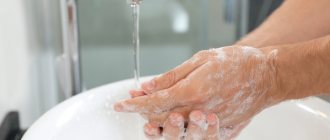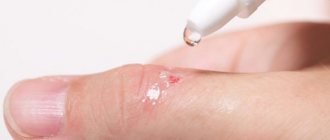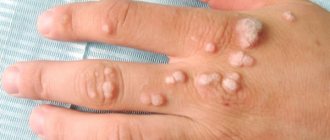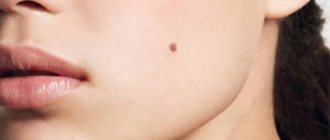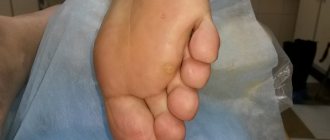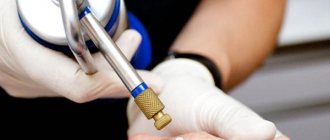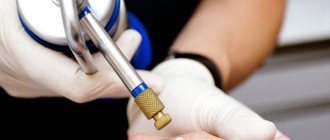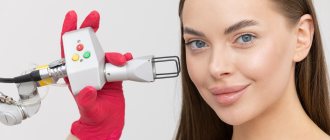Finally the warts disappeared.
In their place only a small wound remained.
She will heal soon.
Unfortunately, not all wart removal operations are successful. Sometimes scars remain. In other cases, inflammation begins. The consequences of removing a wart can be very unpleasant, so care must be taken to ensure proper healing of the wound.
We will discuss this issue later. For now, let’s briefly talk about the operation to remove warts and in what cases it is performed.
People have tumors removed for a variety of reasons.
Some people don’t like the appearance of warts and the way they look.
Others experience discomfort. Sometimes tumors grow in inconvenient places - on the fingers or feet. Here they interfere with comfortable wearing of shoes, and are also often damaged and inflamed.
Of course, not everyone has such problems.
But there are still a lot of people who want to get rid of warts.
Usually there are no serious obstacles to the operation, and anyone can easily remove even many tumors.
There are few contraindications:
- Pregnancy
- Exacerbation of herpes
- Suspicion of melanoma
- Inflammation of the skin near the wart
- Predisposition to scar formation
Doctors use several methods to combat tumors. Most popular:
- Laser therapy
- Cryodestruction
- Surgical removal
- Electrocoagulation
In principle, all methods are effective. But in recent years, patients often prefer laser surgery due to its high efficiency and lack of pain.
Regardless of the method of wart removal, negative consequences are possible.
Yes, with laser therapy they occur less frequently. However, there is still a risk.
It is important to take care of the wound from a removed wart all the time until it heals completely.
This period depends on several factors:
- Size of tumor
Wounds less than a centimeter heal in two weeks. In larger areas, the skin takes longer to recover—up to a month.
- Immunity status
A strong immune system speeds up healing.
- Compliance with doctor's recommendations
Due to improper care, tissue restoration can take several months, and sometimes the wound does not heal at all and the help of a doctor is needed.
As you can see, any patient can speed up recovery after surgery. You just need to be patient and follow the doctor's instructions - take care of the wound and use the right medications.
How does laser affect tissue?
Let's figure out how a CO2 laser affects tissue when it cauterizes tumors. The doctor directs the laser beam at the area of removal; when the beam hits the tissue, it is reflected and causes pendulum-like movements of the molecules, which leads to the evaporation of water from the cell and charring of the tissue. Part of the energy is transferred to surrounding cells, in which, under the influence of high temperatures, reversible protein denaturation occurs. It is the latter effect that causes the appearance of redness and swelling around the cauterization site.
But I would like to note that the surface after laser removal has a number of differences from other types of wounds, for example after a scalpel or electrocoagulation:
- The incision is made without touching the surface of the skin, this 100% guarantees the risk of infection;
- The laser coagulates the superficial layers of the dermis, while the deep ones remain undamaged, which is why it does not cause scarring and stenosis;
- Another feature is that after laser exposure in tissues, the temperature rises, this leads to the death of bacteria and viruses, thus it has an antiseptic effect;
- In the area affected by the laser, due to high temperatures, the vessels are sealed, so there is no bleeding, and a dense scab is formed that closes the wound, preventing bacteria from entering it;
- After laser exposure, regenerative processes at the site of exposure are stimulated due to the penetration of a small amount of light quanta into the deep structures of the skin;
- Compared to other types of cauterization, with laser cauterization the swelling around the wound is less pronounced and therefore there is no pain after laser removal.
Thanks to the above symptoms, the wound heals faster after laser, almost never suppurates or causes pain, and most importantly, does not lead to the formation of scars.
Prices:
Prices for removal of formations
| Consultation with a dermato-oncologist surgeon | FOR FREE |
| Dermatoscopy: | |
| - for all education | 500 rub. |
| Skin mapping: | |
| 1-3 formations | 500 rub. |
| 4-10 formations | 2,000 rub. |
| 11-25 formations | 4,000 rub. |
| 26-50 formations | 6,000 rub. |
| Histological examination: | |
| Histology Dialab | 1,500 rub. |
| Histology Hemotest | 3,000 rub. |
| Revision of glasses by expert morphologist Prof. Mordovtseva V.V. | 6,000 rub. |
| Local anesthesia: | |
| - injection | 300 rub. |
| - cream | 300 rub. |
| Laser removal of 1 formation on the skin: | |
| diameter: | |
| - up to 1 mm | 100 rub. |
| - up to 2 mm | 400 rub. |
| - up to 3 mm | 600 rub. |
| - up to 4 mm | 700 rub. |
| — up to 5 mm | 800 rub. |
| - up to 6 mm | 900 rub. |
| - up to 7 mm | 1,000 rub. |
| - up to 8 mm | 1,100 rub. |
| - up to 9 mm | 1,200 rub. |
| - up to 10 mm | 1,300 rub. |
| Laser removal of 1 formation on the skin of the eyelids, mucous membranes, plantar and periungual: | |
| - up to 1 mm | 300 rub. |
| - up to 2 mm | 400 rub. |
| - up to 3 mm | 700 rub. |
| - up to 4 mm | 800 rub. |
| — up to 5 mm | 900 rub. |
| - up to 6 mm | 1,000 rub. |
| - up to 7 mm | 1,100 rub. |
| - up to 8 mm | 1,200 rub. |
| - up to 9 mm | 1,300 rub. |
| - up to 10 mm | 1,400 rub. |
| Chalazion removal | 7,000 rub. |
| Laser removal of 1 formation on the ciliary edge of the eyelids: | |
| - up to 1 mm | 500 rub. |
| - up to 2 mm | 1,000 rub. |
| - up to 3 mm | 1,500 rub. |
| - up to 4 mm | 2,000 rub. |
| — up to 5 mm | 2,500 rub. |
| Excision of formations with suturing: | |
| Excision of formations with 5 mm sutures on the body | 1,500 rub. |
| Excision of formations with sutures on the face M-zone (cheeks, forehead, chin, temple, scalp) - 5 mm | 2,500 rub. |
| Excision of formations with sutures on the face H-zone (nose, eyelids, lips, ears) - 5 mm | 5,000 rub. |
| Excision of formations with 5 mm sutures on the hands and feet | 2,500 rub. |
| Excision of formations using the Mohs method + cost of wound closure: | 30,000 rub. |
| on the face M-zone (cheeks, forehead, chin, temple, scalp) - 5 mm | 2,500 rub. |
| on the face H-zone (nose, eyelids, lips, ears) - 5 mm | 5,000 rub. |
| Removal of molluscum contagiosum in children under 10 years of age: | |
| - for one education | 300 rub. |
| Laser correction of ingrown toenails (one side of the nail): | |
| Laser correction with removal of the growth zone | 3,500 rub. |
| Resection of an ingrown nail without removing the growth zone | 1,900 rub. |
| Removing the thumbnail | 1,700 rub. |
| Removal of the nail on the 2nd to 5th finger | 1,000 rub. |
| Earlobe correction: | |
| — After earrings (for 1 side) | 3,000-6,000 rub. |
| — Correction of the shape of the lobes, including tunnels (for 1 side) | 10,000 rub. |
| Excision of scars (per 1 cm incision): | |
| Excision of scars on the body, 1 cm of scar | 3,000 rub. |
| Excision of scars on the face and neck, 1 cm of scar | 5,000 rub. |
| Correction of body scar with local tissues, 1 cm of scar | 5,000 rub. |
| Correction of face and neck scars with local tissues, 1 cm of scar | 10,000 rub. |
| Correction of retracted scars with Collost filler 7% - 1.5 ml | 13,000 rub. |
| Correction of retracted scars with Collost filler 15% - 1.5 ml | 18,000 rub. |
| Collost micro – 150 mg | 20,000 rub. |
| Spherogel Lights 0.5 ml | 7,000 rub. |
| Spherogel Lights 1.0 ml | 12,000 rub. |
| Spherogel Medium 0.5 ml | 9,000 rub. |
| Spherogel Medium 1.0 ml | 16,000 rub. |
| Scar hormone therapy (Diprospan) | 1,300 rub. |
| Laser resurfacing CO2 1 cm2 | 2,000 rub. |
| Biopolymer removal | 40,000 rub. |
How long does it take for a wound to heal after laser removal?
The duration of the complete healing period depends on many factors:
- from the structure of the tissue itself, for example, the mucous membrane is restored faster than the rough thick skin on the feet or palms;
- depending on the intensity of the blood supply to the area where the removal took place, well-supplied areas heal 2 times faster than, for example, the heels and feet, where there is practically no blood flow in the superficial layers of the dermis;
- depending on the size of the wound that formed after removal, defects of small diameter heal 3 times faster.
Already at the end of the first day, the number of cells involved in regeneration increases along the periphery of the wound (for comparison with other methods of exposure only at the end of 3 days). By 5-7, there is an active process of angiogenesis, the germination of new vessels. And by 14-20 days, the tissue structure is completely restored without the formation of scar changes.
In what cases should you consult a doctor again?
When serous or purulent discharge, odor, redness, pain appear from the wound - such situations can occasionally occur within 7 days. You need to see a doctor about this. After the examination, the doctor will give recommendations for further care.
After the first month, when the scar has formed, it is most often normotrophic - neat and already similar to the color of the skin. But sometimes a trophic, hypertrophic or keloid scar can form. Such a scar can be corrected by a surgeon or contact a cosmetologist who can also help with this.
+7 (495) 255−50−11.
How long does redness and swelling last after laser vaporization?
As we wrote above, swelling after laser removal is rare and goes away quickly. Most often, swelling occurs during removal of tissues with good blood supply and thin epidermis, for example, when removing papillomas on the eyelid, condylomas on the genitals, or the oral mucosa. Swelling usually appears within a day and completely disappears after 3 days. When removing calluses and warts on the foot and palm, there is no swelling, since the hydrophilicity of the tissues in this area is low.
Redness around the wound after laser removal is not common, since the blood vessels are sealed in the affected area. Like swelling, redness often appears in areas where the skin is very thin and sensitive. Redness should not persist for more than 2 days. If the redness does not go away or begins to increase, you need to rule out inflammation and be sure to see a dermatologist for an examination.
Does the wound hurt after removal?
Laser is a unique method of influencing tissue, which causes complete destruction of neoplasm cells without affecting nearby healthy cells. We have already written above that swelling does not form in the cauterization area, accordingly, peripheral nerve receptors are not irritated and therefore the sore that forms after laser removal does not hurt. Of course, if the scab is in a place of constant pressure (for example, on the foot) or comes into contact with clothing (bra or belt), then discomfort may occur. There is no need to resort to taking painkillers; all sensations in the area are simply unpleasant sensations.
Contraindications
Like any medical procedure, laser wart removal has its contraindications, which include:
- Having a cold or infectious disease;
- Exacerbation of chronic diseases;
- Herpes infection during exacerbation;
- Increased blood pressure before the procedure;
- Malignant formations;
- The presence of other oncological diseases;
- Skin irritations and rashes in the affected area;
- Increased body temperature;
- Kidney and liver failure;
- Diabetes mellitus and other metabolic diseases;
- Pregnancy and lactation period.
How to care for a wound after cauterization
After laser removal, the scab is dense and dry; it tightly covers the damaged tissue from bacteria and other substances. Often, dermatologists simply ask not to touch the cauterization area, and not to treat it with anything. Wear natural fabrics to allow air to flow freely to this area, as the healing process in the open air is much faster. Also, for the first week, do not wet the area too much so that the sore does not get wet.
If the damage is localized in hard-to-reach and ventilated areas, it is additionally recommended:
- To reduce pressure on the cauterized area on the foot, wear loose shoes and use special orthopedic gel protectors;
- After removal, treat the mucous membranes with antiseptics (chlorhexidine, miramistin) 2 times a day;
- If the wound gets wet, it is dried with flucarcin for the first three days.
Postoperative period
After removing a wart, a crust forms in its place, which is prohibited from being picked off yourself. Removing the scab before it dries can result in a scar. After some time, it will dry out on its own and disappear, provided that the doctor’s instructions are followed.
After the removal procedure, it is recommended to follow simple rules to eliminate the risk of complications:
- Avoid visiting saunas, baths, swimming pools, as well as taking a bath, so as not to wet the crust and not expose it to wet steam;
- Use protection from ultraviolet rays;
- Do not use cosmetics on the area where the wart was removed;
- Do not cover the wound with a band-aid;
- Treat the wound with a disinfectant;
- Take medications prescribed by your doctor.
Causes of warts
The main cause of warts on the human body is the human papillomavirus (HPV), which is very common and highly variable. In total, more than one hundred and fifty types of HPV are known, but only a few of them lead to the appearance of warts. The background that provokes HPV infection and the development of tumors on human skin are the following factors:
- Weakened immunity.
- Chronic diseases.
- Constant stress.
- Poor nutrition.
- Damage and diseases of the skin.
The “gate of entry” for HPV can be microtraumas - wounds, abrasions and cracks in the skin. Therefore, the method of transmission of the virus into the human body can be carried out by touching the patient or using the same objects with him - for example, a computer keyboard. You can often catch the virus in a bathhouse, swimming pool or gym.
Another source of infection is sick animals. Workers involved in cutting meat or fish are especially at risk; when infected, their hands, fingers and forearms are most often affected.
Warts grow quickly and can spread across the skin. If a neoplasm is injured, there is a possibility of spreading and new forms appearing on the skin. In addition, with frequent trauma, constant pain occurs in the area of the wart, which can cause physical discomfort. If you self-medicate, scars may remain on the skin. In addition, with constant trauma, warts can become malignant.
